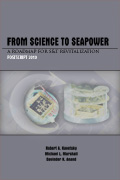From Science to Seapower: A Roadmap for S&T Revitalization
POSTSCRIPT 2010
R. Kavetsky, M. Marshall, and D.K. Anand
ISBN 978-0-9846274-1-7
CALCE EPSC Press, University of Maryland, MD, 2010
 |
“This book tackles head-on the challenge of building future naval capabilities while the nation is at war. Past scientists, engineers and military working for the Navy/Marine Corps team had the vision and dedication to develop our current superior array of military capabilities that have served this nation so well. Present leaders in our naval labs and warfare centers now have the responsibility to ensure that we do not lose this significant technical advantage. A forward-looking research and development strategy is a strategic requirement if we intend to ensure our future forces have the necessary technical capabilities. From Science to Seapower presents an insightful treatment of the big challenges and offers a practical way-ahead.” GEN (ret) Michael Hagee |
|
|---|
The first edition of this book, published almost five years ago, highlighted the importance of the Department of the Navy’s (DON) inhouse laboratories and warfare/systems centers as a source of discovery and invention of new ideas with military relevance. It was published with the hope that the book's
analysis, findings, and policy recommendations would help reverse some of the damage these labs and centers had sustained over the course of more than a decade of downsizing and outsourcing following the end of the Cold War.
In the years since the first book was written, the world situation has evolved in ways that impact the U.S. national security enterprise, including DOD’s in-house laboratories and centers. For one thing, even as the Iraq war winds down, the U.S. remains entrenched in a grueling conflict in Afghanistan, and the world-wide jihadist threat continues unabated. These circumstances will further increase the pressure on defense labs to support today’s warfighting needs, often at the expense of a much-needed longer-term research focus. Another factor is the global
financial meltdown that has left many countries with stagnant economies and accumulating debt. There is mounting concern in the U.S. over its own debt burden. Any budget-cutting efforts will doubtless target military spending, which remains the largest discretionary element of the U.S. budget. Some of these cuts will surely fall on the labs and centers, hindering their efforts to revitalize existing S&E workforces, which are struggling to replace Baby Boom generation talent that is retiring in increasing numbers. Continued R&D globalization will also affect the labs’ and centers’ ability to mine a growing world-wide S&T database for new, militarily-useful ideas. Globalization, a subject discussed at some length in the book, has already contributed to an accelerating accumulation of technical infrastructure and talent in countries such as India and China, a trend that raises numerous issues for
the entire U.S. national security enterprise.
These and other environmental factors have affected some of our original findings and recommendations. Because a complete rewrite of the book is impractical at this time, the authors have opted instead to include a short update at the end in an attempt to address some of the changes and events that have occurred since it was first published. Also this new edition contains an index to assist those less familiar with its subject matter. Finally, the authors believe that S&T Revitalization is a work in progress requiring constant leadership support since it goes to the heart
of National Security.
Contact Ania Picard at picard@cecd.umd.edu to order a copy of this book.

